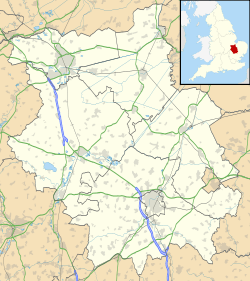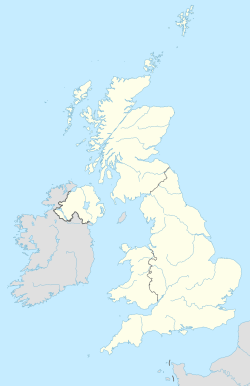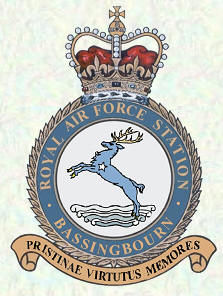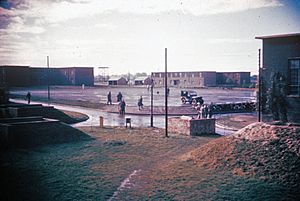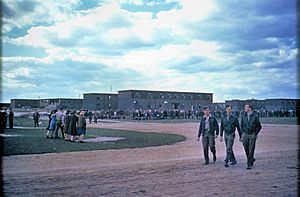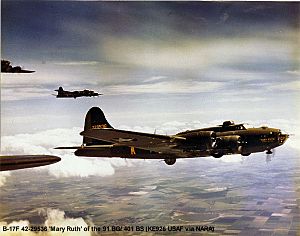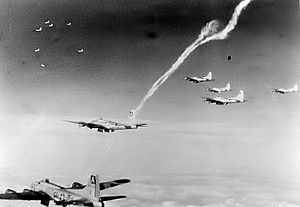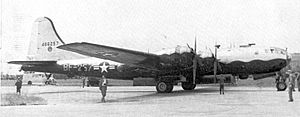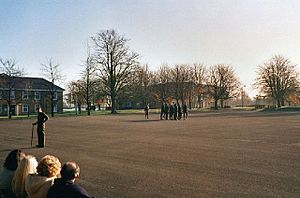RAF Bassingbourn facts for kids
Quick facts for kids RAF BassingbournUSAAF Station 121 |
|||||||||||
|---|---|---|---|---|---|---|---|---|---|---|---|
| Royston, Cambridgeshire in England | |||||||||||

1955 Aerial photograph
|
|||||||||||
|
Shown within Cambridgeshire
|
|||||||||||
| Coordinates | 52°05′48″N 000°03′11″W / 52.09667°N 0.05306°W | ||||||||||
| Grid reference | TL335458 | ||||||||||
| Type | Royal Air Force station * Parent Station |
||||||||||
| Code | BS | ||||||||||
| Site information | |||||||||||
| Owner | Ministry of Defence | ||||||||||
| Operator | Royal Air Force United States Army Air Forces United States Air Force |
||||||||||
| Controlled by | RAF Bomber Command (1938-1942; 1951-1969) * No. 3 Group RAF * No. 6 (T) Group RAF * No. 7 (T) Group RAF * No. 92 (OTU) Group RAF Eighth Air Force (1942-1945) RAF Transport Command (1945-1949) United States Air Forces in Europe (1950-1953) British Army (1969 – present) |
||||||||||
| Site history | |||||||||||
| Built | 1937/38 | ||||||||||
| Built by | John Laing & Son Ltd | ||||||||||
| In use | March 1938 - 2014 | ||||||||||
| Battles/wars | European theatre of World War II Cold War |
||||||||||
| Airfield information | |||||||||||
| Elevation | 24 metres (79 ft) AMSL | ||||||||||
|
|||||||||||
RAF Bassingbourn was once a very important Royal Air Force (RAF) station in Cambridgeshire, England. It is about 3 miles north of Royston and 11 miles southwest of Cambridge.
During World War II, it was first an RAF base. Later, it became a key airfield for American bombers. Today, it is home to the Tower Museum Bassingbourn, which tells its amazing story.
Contents
Building RAF Bassingbourn
How the Airfield was Built
Construction of RAF Bassingbourn started in 1937. The company John Laing & Son built it between 1937 and 1939. The site was chosen because it was low and often misty, which helped hide the airfield from enemy planes.
The ground was a bit swampy, so builders had to work hard. They poured extra thick concrete for roads and buildings. This stopped them from sinking into the soft ground.
The base was made to look nice with permanent streets. Hundreds of plum trees were planted, making it one of the prettiest RAF stations.
Runways and Camouflage
At first, the runways were just grass. Light bombers like the Bristol Blenheim could use them. But heavier bombers would damage the grass.
So, in 1941–1942, three concrete runways were built. These were covered with asphalt. The main runway was made extra long, about 1,825 meters.
The airfield also had special areas for planes to park. There were 35 "pan" shaped parking spots and 16 loop-shaped ones. These could hold up to 67 bombers.
Bassingbourn used clever camouflage to hide its runways. Before concrete, the grass runways were painted to look like fields. After concrete, the areas between runways were painted to look like crops.
RAF Bassingbourn: Early Years (1938–1942)
The airfield opened in March 1938. Two squadrons, 104 and 108, moved in with their Hawker Hind light bombers. Soon after, they switched to Bristol Blenheim bombers.
When World War II began in September 1939, these squadrons moved. Other RAF training squadrons then used Bassingbourn. They trained aircrews to fly Vickers Wellington and Avro Anson planes.
The base was attacked by a German plane in May 1940. From March to August 1941, German planes often attacked at night. On August 13, 1941, a bomb hit a building, sadly killing 10 people.
In May 1942, planes from Bassingbourn joined a huge "Thousand Bomber" raid on Cologne, Germany. They also took part in other large raids until September 1942.
American Bombers Arrive (1942–1945)
In 1942, the United States Army Air Forces (USAAF) started using Bassingbourn. It became known as USAAF Station 121. From August 1942 to June 1945, it was a main base for American bombers.
The 91st Bomb Group: Flying Fortresses
The 91st Bomb Group arrived at Bassingbourn on October 14, 1942. They flew Boeing B-17 Flying Fortress bombers. The base was so well-equipped that the Americans called it "the country club."
The 91st Bomb Group started flying missions on November 7, 1942. They mostly attacked German submarine bases and factories. They also targeted airfields and railway yards.
The group earned two special awards for their bravery. One was for bombing railway yards in Hamm, Germany, in bad weather. The other was for attacking aircraft factories in central Germany in January 1944.

The 91st Bomb Group also helped with the D-Day landings in June 1944. They bombed enemy gun positions and troop areas. They continued flying missions until April 25, 1945.
Sadly, 197 B-17s from the 91st Bomb Group did not return to Bassingbourn. This was the highest loss for any American bomber group in the UK. After the war, the group helped bring prisoners of war home. They returned to the United States in July 1945.
More American Squadrons
The 94th Bombardment Group also used Bassingbourn for a short time in 1943. They flew a few missions from the base before moving to another airfield.
Bassingbourn in the Movies
Bassingbourn was a popular spot for filmmakers. In 1943, it was featured in the documentary film Memphis Belle: A Story of a Flying Fortress. A propeller from the famous Memphis Belle plane is still at the base today.
The author John Steinbeck also wrote newspaper articles about the airfield. Even famous actor Clark Gable worked there on a film for the USAAF. The base was used for the fictional "28th Bomb Group" in the 1950 movie Chain Lightning.
Later, in 1955, parts of The Dambusters movie were filmed at Bassingbourn. In 1986, Stanley Kubrick used the barracks to film scenes for his movie Full Metal Jacket.
After the War: New Roles
Helping with the Berlin Airlift
The RAF took over Bassingbourn again in June 1945. It became a major base for long-range transport planes. In 1948 and 1949, planes from Bassingbourn helped with the Berlin Airlift. This huge operation delivered food and supplies to the city of Berlin.
American Air Force Returns
In the late 1940s, American B-29 and B-50 bombers visited the UK. These visits were a way to show strength during the Cold War. They sent a message that the United States was ready to protect Western Europe. These deployments happened from August 1950 to May 1951.
Jet Bombers and Training
In 1952, RAF Bassingbourn became home to English Electric Canberra jet bombers. It was the first place in the world to train pilots on these new jet bombers. Canberras flew from Bassingbourn for 17 years. You can still see one of these planes at the barracks today.
Bassingbourn Becomes an Army Base
On August 29, 1969, the RAF handed the station over to the British Army. It became Bassingbourn Barracks in January 1970. It was a training center for new army recruits.
For almost 20 years, it was the home of the Army Training Regiment. Bassingbourn Barracks closed as a training location in August 2012. It reopened in December 2018 as the Mission Training and Mobilisation Centre.
Images for kids
See also
- Strategic Air Command in the United Kingdom
- List of former Royal Air Force stations
- List of British Army Barracks




